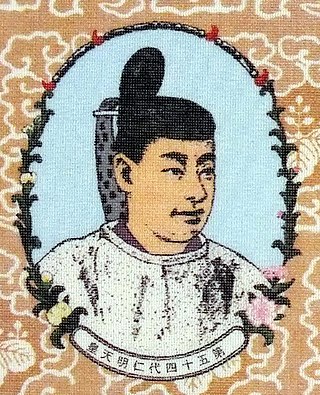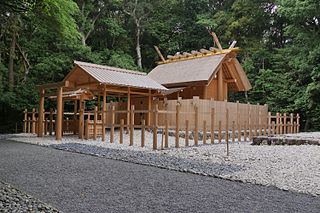
Emperor Kanmu, or Kammu, was the 50th emperor of Japan, according to the traditional order of succession. Kammu reigned from 781 to 806, and it was during his reign that the scope of the emperor's powers reached its peak. His reign saw the transition from the Nara period to the Heian period.

Emperor Tenmu was the 40th Emperor of Japan, according to the traditional order of succession. He ascended to the throne following the Jinshin War, during which his army defeated that of Emperor Kōbun. Tenmu reigned from 673 until his death in 686, amid the late Asuka period.

Emperor Suinin, also known as Ikumeiribikoisachi no Sumeramikoto (活目入彦五十狭茅天皇) was the 11th legendary Emperor of Japan, according to the traditional order of succession. Less is known about Suinin than his father, and likewise he is also considered to be a "legendary emperor". Both the Kojiki, and the Nihon Shoki record events that took place during Suinin's alleged lifetime. This legendary narrative tells how he ordered his daughter Yamatohime-no-mikoto to establish a new permanent shrine for Amaterasu, which eventually became known as the Ise Grand Shrine. Other events that were recorded concurrently with his reign include the origins of Sumo wrestling in the form of a wrestling match involving Nomi no Sukune.

Emperor Ninmyō was the 54th emperor of Japan, according to the traditional order of succession. Ninmyō's reign lasted from 833 to 850, during the Heian period.

Emperor Murakami was the 62nd emperor of Japan, according to the traditional order of succession.

The Ise Shrine, located in Ise, Mie Prefecture of Japan, is a Shinto shrine dedicated to the solar goddess Amaterasu. Also known simply as Jingū (神宮), Ise Shrine is a shrine complex composed of many Shinto shrines centered on two main shrines, Naikū (内宮) and Gekū (外宮).

Meiwa is a town located in Mie Prefecture, Japan. As of 1 August 2021, the town had an estimated population of 23,015 in 9309 households and a population density of 560 persons per km². The total area of the town was 40.92 square kilometres (15.80 sq mi).

The Aoi Matsuri (葵祭), or "Hollyhock Festival", is one of the three main annual festivals held in Kyoto, Japan, the other two being the Festival of the Ages and the Gion Festival. It is a festival of the two Kamo shrines in the north of the city, Shimogamo Shrine and Kamigamo Shrine. The festival may also be referred to as the Kamo Festival. It is held on 15 May of each year.

Ariwara no Narihira was a Japanese courtier and waka poet of the early Heian period. He was named one of both the Six Poetic Geniuses and the Thirty-Six Poetic Geniuses, and one of his poems was included in the Ogura Hyakunin Isshu collection. He is also known as Zai Go-Chūjō, Zai Go, Zai Chūjō or Mukashi-Otoko.

The Saiō Matsuri (斎王まつり) is a 2-day festival held on the first weekend of June in the town of Meiwa, Mie Prefecture in Japan. The Saiō Matsuri celebrates the town's history of once being an Imperial residence. The festival re-enacts the march of the Saiō and her entourage to the nearby Ise Shrine. The festival consists of over 100 people dressed in spectacular Heian period costume, marching down a section of the Ise Kada, the old Ise Pilgrimage road, toward the Saikū Historical Museum. 2006 saw the celebration of the 24th annual Saiō Matsuri.

Yamatohime-no-mikoto is a Japanese figure who is said to have established Ise Shrine, where the Sun Goddess, Amaterasu Omikami is enshrined. Yamatohime-no-mikoto is recorded as being the daughter of Emperor Suinin, Japan's 11th Emperor.
Ōku was a Japanese princess during the Asuka period in Japanese history. She was the daughter of Emperor Tenmu and sister of Prince Ōtsu. As a young girl, she witnessed the Jinshin War. According to the Man'yōshū, she became the first Saiō to serve at Ise Grand Shrine. After the death of her brother Prince Ōtsu in 686, she returned from Ise to Yamato to enshrine his remains on Mt. Futakami, before a quiet end to her life at age 40.
Saiin or Itsuki no In (斎院) were female relatives of the Japanese emperor who served as High Priestesses in Kamo shrines. Saiin princesses were usually elected from royalty or princess. In principle, Saiin remained unmarried, but there were exceptions. Some Saiin became consorts of the Emperor, called Nyōgo in Japanese. The Saiin order of priestesses existed throughout the Heian and Kamakura periods.

Lady Rokujō is a fictional character in The Tale of Genji. She is a mistress of the novel's protagonist, Hikaru Genji, with whom she becomes infatuated with and jealous of his other lovers. Her jealousy subconsciously causes her ikiryō to become a Shiryo that attacks and murders multiple other mistresses and wives of Genji.

The Saikū (斎宮) was a palace complex located in what is now the Takegawa neighborhood of the town of Meiwa, Taki District, Mie Prefecture, Japan. Forming a small village, it was established in the Nara period as the palace and public offices of the Saiō, an unmarried Imperial princess who served at Ise Shrine on behalf of the emperor, and fell into ruins in the Nanboku-chō period. The site was designated a National Historic Site in 1979. The Saikū is also referred to as the "Bamboo Palace", Saigū, Itsuki no Miya, Iwai no Miya or Imimiya
Princess Taki was a Japanese princess during the Asuka period of Japanese history. She was a daughter of Emperor Tenmu, a wife of Prince Shiki and the mother of Prince Kasuga. She was a saiō.

The Natsumi temple ruins is an archaeological site with the ruins of an Asuka to Nara period Buddhist temple located in the Natsumi neighborhood of the city of Nabari, Mie Prefecture, Japan. The temple no longer exists, but the temple grounds were designated as a National Historic Site in 1990.

Nonomiya Shrine, or the Shrine in the Country, is a Shinto shrine in the Arashiyama district on the west side of the city of Kyoto in Kyoto prefecture, Japan, close to its bamboo forest. The specific site of the shrine changed somewhat over time, as the location of the shrine was fixed anew by divination when a new imperial priestess was to undergo purification before traveling to take up her duties at Ise Shrine.

The Tarumi Saiō Tongū Site is the location of a temporary palace erected in the Heian period in what is now the city of Kōka, Shiga Prefecture in the Kansai region of Japan. The site was designated a National Historic Site of Japan in 1944.

Izawa-no-miya (伊雑宮) is a Shinto shrine in the Kaminogō neighborhood of Isobe in the city of Shima in Mie Prefecture, Japan. It is one of the two shrines claiming the title of ichinomiya of former Shima Province. Together with the Takihara-no-miya (瀧原宮) in Taiki, it is one of the Amaterasu-Ōkami no Tonomiya (天照大神の遙宮), or external branches of the Inner Shrine of the Ise Grand Shrine.























